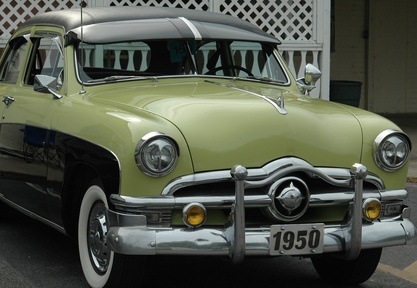
Orange peel in clear coat finish can be compared to craters on the moon, and it's much easier to prevent orange peel than to repair it. Craters are caused when large objects impact a smooth, fluid surface, just like the dust on the moon's surface creates a pit when it is impacted by an asteroid. The same is true when spraying clear coat. If the clear droplets are too large, they create craters when they impact the wet surface. If the droplets were smaller, they would flow into the wet area and not leave craters.
Park the car in a shady area and wet sand the car using progressively finer wet-or-dry sandpaper. Depending on the level of shine desired, begin with sandpaper starting at 1,000 grit and finish with 2,000 grit. Rarely would any job begin with a grit rougher than 1,000 grit. Wrap the paper around a soft sanding pad, available at auto paint stores. Keep water flowing over the surface of the car and begin sanding until the surface is smooth. Periodically use a squeegee to wipe away the water. Small pits will show if the surface is not perfectly smooth. After the surface is free of pits, switch to ever finer sandpaper to remove the sandpaper scratches.
Wash the car to remove all the powdery residue that has been left over after sanding. This residue is the excess clear coat that has been sanded off, and it gets into seams and cracks. It should be removed since it interferes with the buffing process. Wipe the car dry after it is washed.
Buff the car with progressively finer buffing compounds, starting with the most aggressive grit and finishing with the finest grit. Ideally use a complete system such as 3M or McGuire's buffing and polishing lines. Work a small section at a time and use a low-speed buffer designed for automotive buffing applications. Buffing will remove the sandpaper scratches, but it will also leave swirl marks in the clear. To remove these, switch to a polishing pad and use progressively finer polishing compounds. Do not keep the buffer in one spot for too long and burn the clear. Keep it moving, working section by section.
Wash the car and remove all the buffing and polishing residue. This residue will be everywhere, thrown about by the buffer. It takes time and patience to remove it. Raise the truck and hood and wash the residue from the gaps. Open all the doors and remove the residue. Remove the residue from all the glass, and under the wheel openings and off the tires.
Hand glaze the car. Do not wax the car and seal the finish if the paint is new. This will trap volatile solvents in the finish that need to off-gas for two to three months. Instead, apply a glaze that will fill any minor imperfections in the buff and polish job and create a mirrorlike finish. Work in small areas and hand rub the glaze into the clear.